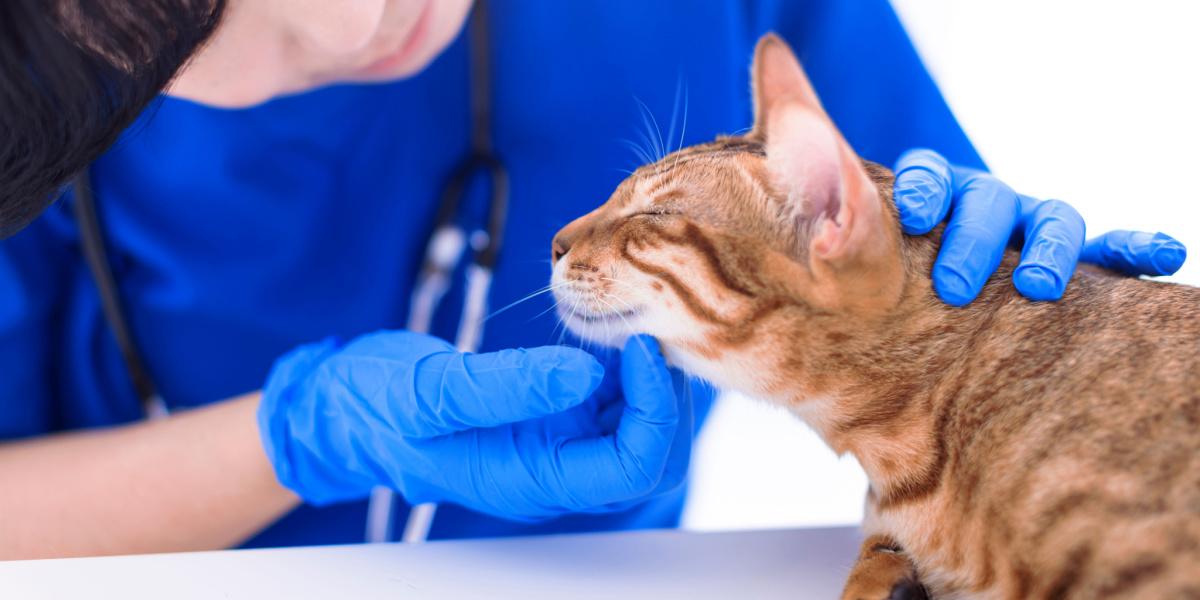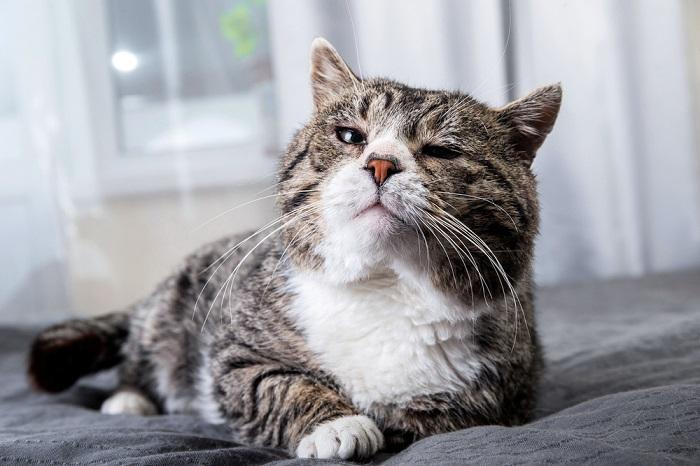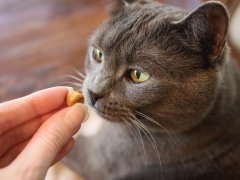
The aim of this article is to provide a simple, clear explanation about enlarged lymph nodes (lymphadenopathy) for cat owners. This is a common finding in sick cats, with many possible causes.
The first stage to learning about lymph node enlargement is to learn about normal lymph nodes, which are a key part of the immune system.
What Are Lymph Nodes?
Most of the immune system works away quietly on its own inside cats, out of sight, producing antibodies, T-cells, and other cells and factors to protect the body against viruses and other threats to health. But there is one part of the immune system that sometimes becomes very obvious: the lymph nodes.
Lymph nodes, also known as “glands,” are small, solid gatherings of immune cells that are found in many parts of the body, including:
- The neck (submandibular)
- In front of the shoulder (prescapular)
- The armpit (axillary)
- The groin (inguinal)
- The back of the knee (popliteal)
- Various internal locations such as the chest (mediastinal) and abdomen (intestines, mesenteric).
Lymph nodes are part of the lymphatic system, a network of narrow lymph vessels that parallel the blood vessels in the body. These lymph vessels gather and channel loose fluid from the extremities of the body, carrying the fluid back to the chest where it’s fed back into the bloodstream.
The lymph nodes are clusters of immune cells (including lymphocytes and white blood cells) which act like biological filters at regular points along the lymph vessels, filtering out debris including bacteria and viruses. The immune cells work hard to neutralize incoming threats to the health of the body.
Lymph nodes in cats are tiny (like small frozen peas) until they become active, when they can swell up many times bigger than this.
What Are Enlarged or Swollen Lymph Nodes (Lymphadenopathy)?
Enlarged lymph nodes (lymphadenopathy or lymphadenomegaly) are diagnosed when one or more lymph nodes is larger than normal.
- Localized lymphadenopathy means that one, or a small number, of lymph nodes are enlarged.
- Generalized lymphadenopathy means that all (or most) of the lymph nodes in the body are enlarged.
What Causes Lymphadenopathy?
Lymph nodes become enlarged for two main reasons:
- Reactive hyperplasia or inflammatory lymphadenopathy or lymphadenitis, when the lymph nodes are reacting to a challenge, such as fungal infections, bacterial infections, viral infections (including feline leukemia virus or feline immunodeficiency virus), or immune reactions (like eosinophilic granulomas or non-neoplastic mast cell infiltrations). Young cats are more likely to be affected by this type of lymphadenopathy.
- Neoplastic hyperplasia, when affected lymph nodes are enlarged because of infiltration by cancerous cells.
Possible Cancer Types Include
1. Primary cancers of the lymphatic system
- Leukemias
- Lymphomas (lymphosarcomas)
- Lymphomatoid granulomatosis
- Malignant histiocytosis
- Multiple myeloma
- Systemic mast cell disease
2. Secondary or metastatic cancers from a primary source
- Carcinomas
- Sarcomas
How Common Is Lymphadenopathy?
Lymphadenopathy is only seen occasionally. It is normally detected by veterinarians during routine physical examinations of sick cats.
Symptoms of Lymphadenopathy in Cats

In addition to enlarged lymph nodes, cats with lymphadenopathy may have other signs of poor health, including dullness, loss of appetite, and weight loss.
The clinical signs associated with lymphadenopathy are simple: enlargement of lymph nodes. Sometimes this is noticed by cat carers (e.g., visible swellings under the neck, or at other parts of the body), but more often, it will only be picked up by a veterinarian examining your cat.
Often, cats with lymphadenopathy show general signs of poor cat health, including dullness, loss of appetite, weight loss, and other non-specific signs. These signs are caused by the underlying illness that is causing the lymphadenopathy, rather than being caused by the lymphadenopathy itself.
Diagnosis and Investigation of Lymphadenopathy
If your veterinarian discovers that your cat has lymphadenopathy, the following steps may be taken.
1. Detailed History Taking
Your vet will discuss every aspect of your cat’s life and health care. This history will help to differentiate the various possible causes. As an example, recent vaccination can lead to a benign reactive hyperplasia in some cases.
2. Physical Examination

Cats with feline leukemia are immunocompromised, which may lead to a range of secondary health issues.
Your veterinarian will check your cat over carefully with a physical exam, checking all lymph nodes for possible enlargement, and noting any other physical signs of illness, such as skin lesions or swellings.
3. Fine Needle Aspirate and Other Biopsies
A biopsy (sample of living tissue) from a swollen lymph node is the only way that a definitive diagnosis can be made when investigating enlarged lymph nodes (lymphadenopathy).
This usually involve a fine needle aspirate (FNA), which is the quickest, simplest, least invasive way of collecting a sample. This is a procedure that can often be carried out in a conscious cat, in the consulting room.
This involves pushing a fine needle into the enlarged lymph node, squirting the contents of the needle onto a glass microscope slide, and sending it to the laboratory for analysis.
Cytology will be carried out on these fine needle aspiration samples, with a pathologist examining the samples, identifying the type of cells present on the slide, and this will often lead to a diagnosis of the cause of the lymphadenopathy.
Sometimes, a second, larger, lymph node biopsy sample (e.g. a core biopsy, or even an excisional biopsy, by excision of the entire lymph node) may be needed for the most accurate diagnosis. Full histopathology is then carried out, allowing more information to be discovered about the disease process.
This procedure will usually require that the cat is admitted to the veterinary hospital, and general anesthesia is usually needed for this type of biopsy, as this is a type of surgical procedure.
4. Routine Blood and Urine Tests
As part of a general minimum database to assess cat health when working up a pet that has any type of illness, vets often carry out routine blood work, including the usual panel of diagnostic tests, such as hematology (complete blood count) and biochemistry profiles.
Full urinalysis may also usually be undertaken.
These basic tests are a useful way of checking for any other underlying illnesses, and the results act as a useful baseline to monitor the future health of the cat, even if no immediate abnormality is found.
This background workup may or may not be done for your cat, depending on the details of the situation.
5. Specialized Blood Tests
Your veterinarian may recommend specific blood tests for some viral infections, such as FeLV and Feline Immunodeficiency Virus (FIV): Symptoms, Causes, Diagnosis & Treatment, since there are significant implications if your cat is positive for either of these.
6. Diagnostic Imaging
Radiography (x-rays) and ultrasound may be carried out to examine your cat’s internal organs, checking for enlarged internal lymph nodes, and to screen your cat for other internal diseases.
These investigations are not just important for making the initial diagnosis, they are also part of the staging process, searching for any evidence of metastases (spread of tumors to elsewhere in the body), which would help with decision making around treatment plans for some causes of lymphadenopathy.
Treatment for Lymphadenopathy

Treatment for lymphadenopathy depends on what is causing the enlarged lymph nodes.
There is not single treatment regime for lymphadenopathy. The treatment depends on the underlying cause of the enlarged lymph nodes.
This can include anti-fungals if the cause is fungal, antibiotics if the cause is bacterial, and anti-cancer treatments (chemotherapy or radiation therapy) in cats that are diagnosed with lymphadenopathy caused by cancers.
How Much Does It Cost To Treat a Cat With Lymphadenopathy?
It is impossible to estimate this cost of treating cases of lymphadenopathy, as there are many possible factors going on in the background of individual cases. You should ask your veterinarian for a detailed estimate. Pet insurance is useful for cases of lymphadenopathy, as extensive investigations and treatments may be needed.
Monitoring and Prognosis
Regular veterinary examinations are needed to review how your cat’s lymph nodes are progressing.
Conclusion
Lymphadenopathy or enlarged lymph nodes is a sign of underlying illness that is sometimes seen in cats. It is important to use your veterinarian to make an accurate diagnosis of the underlying cause so that appropriate treatment can be given.
Frequently Asked Questions
How can I tell if my cat has lymphadenopathy?
A cat with lymphadenopathy has enlarged lymph nodes, which you may or may not detect yourself. It is easy to examine a cat to feel whether their lymph nodes are enlarged, but it would be best that your local veterinarian demonstrates this examination to you directly. It is difficult to explain in words how to do this.
Can lymphadenopathy in cats go away on its own?
In some cases of reactive lymphadenopathy, the lymph nodes will return to normal on their own, as your cat's immune system responds to the challenge. However this may not happen, and in the meantime, if your cat has a serious cause of lymphadenopathy (e.g., cancerous) then valuable time may be lost by delaying treatment unnecessarily. For this reason, all cats with lymphadenopathy should be taken to the vet promptly.
What can cause lymphadenopathy in cats?
The benign type of lymphadenopathy, reactive hyperplasia, can be caused by fungal infections, bacterial infections, viral infections, or immune reactions (such as non-neoplastic mast cell infiltrations).
The more sinister type of lymphadenopathy, neoplastic or cancerous hyperplasia, develops when affected lymph nodes are enlarged because of infiltration by cancerous cells.








I took two of my cats to get rabies. Both started acting funny. Or passed away and the other I found the enlarged lymph last night. The shots were given for reduced price at an animal function through the health department. I originally thought had tooth until I read this. This is going to be very expensive . My cat is almost 5 yrs old. Very healthy until now. Looks like health department is yet to g a call..
It would be helpful to find out more information as to kitten lymph node enlargement with no physical symptoms, especially when it occurs post rabies vaccination. No article ever mentions should cat act absolutely normal and have such enlarged nodes and possible reason, besides go to vet, do tests and such.
Thanks for this interesting question. In general, the lymph nodes react (get bigger) in response to some type of activation of the immune system, so if enlargement happens after exposure to a virus, or to a vaccine (which is a type of replica virus) then it is very likely that this is a non-sinister reaction to the virus or vaccine. However because of the risk of this being something sinister instead (such as lymphoma), vets are likely to suggest taking samples from the lymph nodes so that they can prove, beyond doubt, that this is not something sinister that needs further action. The risk of finding something sinister may be very low indeed, but the “gold standard” would be to do these tests, to be absolutely safe. I hope this helps a bit.
Very Helpful our 8 year old half ferral white brown cat Raffy we love so much has just had after the antibiotic treatment by our Vet a needle sample sent away for a biopsis How long should this take.
Thank you Mr. & Mrs B Jordan
Thanks for the message, and I apologize for the late reply. It usually takes 1-2 weeks for the results to get back, and your vet can give you information specific to this case.